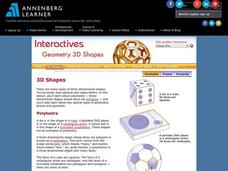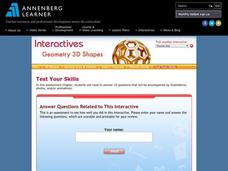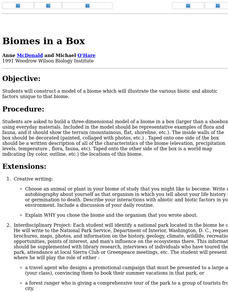Annenberg Foundation
Geometry 3D Shapes: 3D Shapes
Explore vocabulary related to three-dimensional shapes. An instructional website describes the characteristics of different geometric solids. Learners can use an interactive component to view nets, faces, vertices, and edges of common...
Annenberg Foundation
Geometry 3D Shapes: Platonic Solids
From polyhedrons to platonic solids, here is a lesson that will have your classes talking! As an introduction to platonic solids, scholars cut and fold nets to create the three-dimensional solids. They use an interactive component to...
Annenberg Foundation
Geometry 3D Shapes: Euler's Theorem
How do you get a theorem named after you? Euler knows what it takes! The third lesson of five asks pupils to use an interactive activity to compare the faces, vertices, and edges of seven different three-dimensional solids. They use...
Annenberg Foundation
Geometry 3D Shapes: Surface Area and Volume
Whether you wrap it or fill it, you're using geometric concepts. Classmates use an interactive approach to learn how to find volume and surface area of cylinders and prisms in the second lesson in a five-part series. The online lesson...
Annenberg Foundation
Geometry 3D Shapes: Test Your Skills
Time to find out what they've learned! The final lesson of a five-part series has learners complete a 39-question multiple choice review. They use what they've learned in the previous lessons to complete questions that include concepts...
Curated OER
Where is Flat Stanley?
Students create a story map of the basic elements and significant events of the book Flat Stanley. Students brainstorm places they would like to visit if they had been flattened and then, write about an imagined experience. Students...
Curated OER
Combining Geography and Literature by Mapping a Story
Students listen to or read a story on their own. Using the text, they describe the relative locations of the main events. In groups, they develop two and three dimensional maps of the story. They create a key and a title for their map.
Curated OER
Biomes in a Box
Students construct a three-dimensional model of a biome which illustrates the various biotic and abiotic factors unique to that biome. They use everday materials to represent the important characteristics of a particular biome and then...
Curated OER
Guess My Shape
Students describe shapes to other students who have to guess that shape. In this shape lesson plan, students describe shape attributes to other students. Then those other students have to guess the shape that is being described to them....
Curated OER
Mummies Made in Egypt
Pupils use maps to locate information on Egypt, then create their own maps to display knowledge gained from the lesson and Web sites. They recognize, create, and describe the pyramid's geometric shape in three-dimensional forms.
Curated OER
SAMMY DISCOVERS SHAPES AT SCHOOL
Students study maps and use them for real world experiences.
Curated OER
2-D Polygons
Students investigate the concept of two dimensional polygons. They complete a vocabulary chart with the teacher or in independently. Students are shown various polygons in order to classify them and then asked to draw one of them from...
Curated OER
Adam and Eve in Art
First graders observe closely the way a Biblical theme is portrayed in art. They identify the medium of terra cotta as based on clay. They differentiate a sculpted form from paintings.
Curated OER
Investigating Haiti
Young scholars engage in a lesson that is about the island of Haiti. They conduct research using a variety of resources. The information is used in order to help students locate the island on a map. They answer questions while...
Curated OER
Planet of the Apes
The "Planet of the Apes" is becoming a staple in many high school classrooms and provides a way to explore a variety of topics.
Curated OER
Literature Study Contracts
Students complete activities with a leveled chapter book. In this literature lesson, students read a novel and complete several graphic organizers and activities as they read. They focus on characters, settings, vocabulary, and plot.
Curated OER
Directing Me
First graders practice the language of directions and positions in this unit. They follow sequences in which they rotate their bodies and other objects through quarter and half turns while participating in games.


















